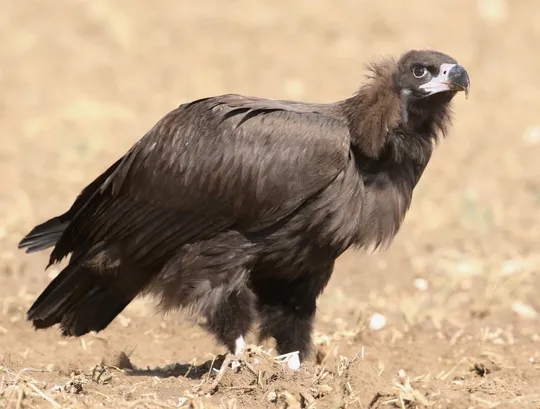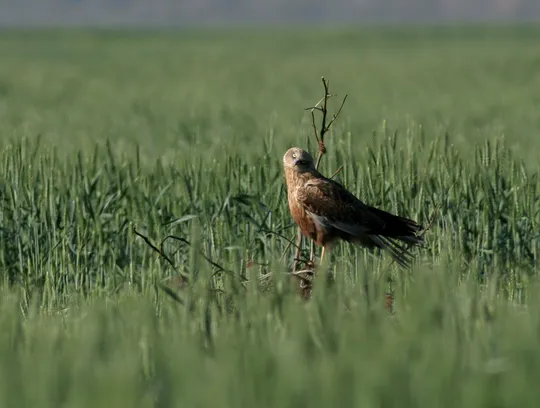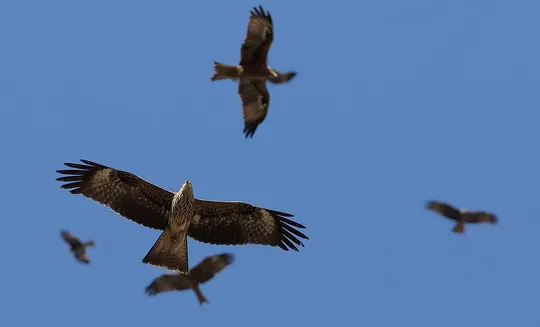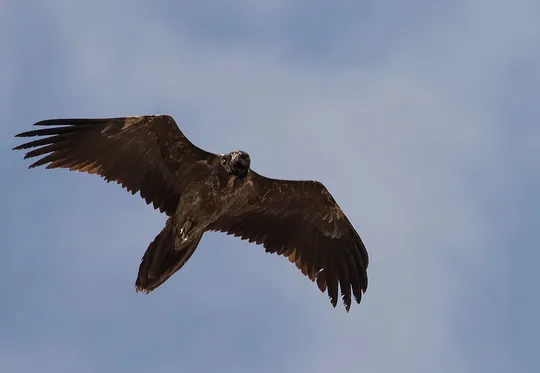Torgos tracheliotus
 Regionally Extinct
Regionally Extinct
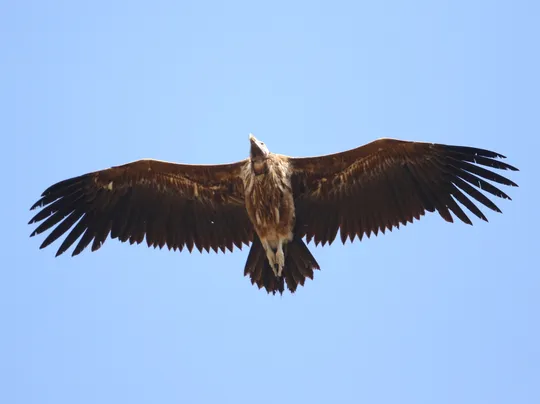
| Habitats | Desert Plains, Acaicia Savanna |
|---|---|
| Presence In Israel | Resident |
| Breeding In Israel | Bred in the past |
| Migration Types | Resident |
| Zoographical Zones | Saharo-Arabian, Sudani |
| Landscape Types | Plains & Valleys, Wide Wadis |
| Vegetation Densities | Low |
| Nest Locations | Tree |
| Diet Types | Carrion |
| Foraging Grounds | Ground |
| Body Sizes | Large (over 1000g) |
| Threat Factors | Hunting and trapping |
The Lappet-faced Vulture is the largest raptor in our region. Plumage is dark brown overall, and head and neck are bald and grey. The breast is light brown, and its legs and cere are grey with a bluish or pinkish hue. Its head is wide and square and its beak is very large. Its wings are long and broad with seven or eight long “fingers”. The wing trailing edge is serrated and wavy, with a sharp transition from the secondaries to the primary feathers. Unlike gregarious vultures, it usually lives alone or in pairs, although in the past there have been sightings of ten or even twenty birds around a carcass in the Arava Valley. The Lappet-faced Vulture feeds on large carcasses, frequently together with other vulture species. Unlike the Egyptian Vulture and the Griffon Vulture, it does not feed at garbage dumps. At the carcass, it has first rights, relative to Egyptian and Griffon vultures. Moreover, it hunts small animals such as rodents. Remains of hares and Egyptian Mastigures were found in its nests.
Until the 1950s, 25-30 pairs of Lappet-faced Vultures nested in the Arava and the Negev. The last nest in the Western Negev was recorded in 1966 in the Nitsana-Shivta area. In 1973, 11 pairs nested in the Arava and the wadis running into it. The number decreased to four pairs in 1980 and to a single pair in 1986-1989. The last nest was recorded in 1989 in the Yotvata area. A pair remained in the Sde Boker area until 1993. Lone individuals are still seen occasionally in Israel every few years, probably originating from the Arabian Peninsula population.
Inhabits desert steppes and broad wadis with scattered acacia trees, on which the large nest is built.
Hunting and trapping: at least eight Lappet-faced Vultures were found shot in the 1950s and 1960s, and at least seven were collected and smuggled into European zoos in the 1970s. The population was presumably also impacted by other disturbance factors such as poisoning, electrocution, lack of food and human disturbances at the nest (Leshem 1984, Shirihai 1996).
A number of Lappet-faced Vultures are held at a captive breeding nucleus, but for the past two decades there has been no successful reproduction.
The Lappet-faced Vulture became extinct as a breeder in Israel in the early 1990s. The probability of the species returning to nest in Israel naturally is low, because the closest population of the subspecies breeds in Saudi Arabia, and it is also declining. The Lappet-faced Vulture could be reintroduced to nature in Israel by a reintroduction project that includes captive breeding, food provision and protection of nesting sites, but the chances of its success are doubtful because of the accelerated development in the southern Negev and the Arava in recent years.
- הצופה, א. ומירוז, א. 2015. תכנית אב לשימור העופות הדורסים בישראל. מסמך פנימי של רשות הטבע והגנים.
- פז, ע. 1986. עופות. מתוך אלון, ע. (עורך), החי והצומח של ארץ ישראל. כרך 6. הוצאת משרד הביטחון, ישראל.
- Leshem, Y. 1984. The rapid population decline of the Israel 's lappet-faced vulture, pp. 41-46. In: International zoo. Yearbook 23, Ed. P.J.S. Olney, The Zoological Society of London .
- Shirihai, H., 1996. The Birds of Israel. Academic Press, London.
- Symes, A. 2013. Species generation lengths. Unpublished, BirdLife International.
- Species page at Birdlife International
Distribution maps
The maps presented here provide visual information on the distribution of species in Israel from the past and present, and the changes in occupancy and breeding density during the comparison period. For further reading
Relative Abundance 2010-2020
Breeding density values in the current decade as determined from experts' opinion and observations from databases.
| Data Missing | Sporadic | Limited Sites | Low Density | High Density |
|---|---|---|---|---|
| 8 | 12 | 12 | 21 | 19 |
Relative Abundance 1980-1990
Density values based primarily on the book The Birds of Israel (Shirihai 1996).
| Data Missing | Sporadic | Limited Sites | Low Density | High Density |
|---|---|---|---|---|
| 5 | 14 | 14 | 17 | 22 |
Occupancy 1990-2020
The map shows differences in the species breeding distribution between the 1980's breeding map and the current weighted breeding evaluation. Negative value - species previously bred in the grid and is not presently breeding; positive value - species has not previously bred in the grid and is currently breeding.
| Data Missing | No Change | Occupancy Increase | Occupancy Decrease |
|---|---|---|---|
| 6 | 35 | 1 | 9 |
Change in Relative Abundance 1990-2020
The map shows the changes in the relative abundance of a species in each of the distribution grids between the breeding map of the 1980s and the weighted current breeding evaluation. Negative values - decline in abundance; positive values - increase in abundance; zero - no change in abundance.
| 80 to 100 | 50 | 20 to 30 | No Change | 30- to 20- | 50- | 100- to 80- | Data Missing |
|---|---|---|---|---|---|---|---|
| 0 | 4 | 2 | 22 | 12 | 14 | 11 | 16 |
| Rarity | |
|---|---|
| Vulnerability | |
| Attractiveness | |
| Endemism | |
| Red number | |
| Peripherality | |
| IUCN category | |
| Threat Definition according to the red book |
